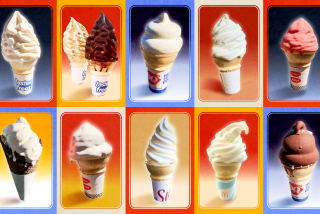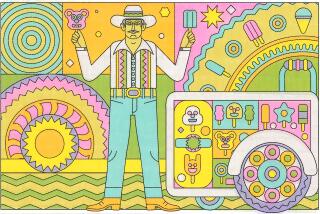Sweet Controversy Swirls Around Ice Cream Cone
- Share via
ST. LOUIS — As the hot and hungry multitudes traipsed through the St. Louis World’s Fair in the summer of 1904, business was good for the ice cream vendors.
Too good, in fact, for one, who sold so much that he ran out of dishes.
Wondering how to sell ice cream without something to put it in, he shared his problem with the waffle-maker in the booth next door.
Hmmm.
What if the waffle were folded to a point at the bottom and the ice cream stuffed inside?
They tried it, people loved it, and the ice cream cone was invented.
Or so the story goes.
Some, including the world’s biggest ice cream restaurant chain, question the long-held belief that the St. Louis World’s Fair was the origin of what remains one of America’s best-loved desserts.
Another story holds that Italian immigrant Italo Marchiony sold ice cream in New York around the turn of the century. As early as 1896, he began wrapping ice cream in cone-shaped paper.
He later figured, why not make the container edible? So he put the ice cream in a pastry and applied for a patent in September 1903.
The patent was granted in December 1903 -- five months before the World’s Fair opened.
Dairy Queen cited Marchiony as the cone inventor by celebrating the 100th anniversary of the ice cream cone on the anniversary of his patent application, Sept. 22.
The company’s restaurants gave away 5-ounce cones. But the Minneapolis-based chain, with about 6,000 restaurants worldwide selling $1 billion worth of ice cream a year, also plans a big event in May in St. Louis to honor the fair’s role in the cone’s development.
“We know there’s controversy, but it’s kind of funny, so we’re going to recognize the patent as well as the World’s Fair,” said Michael Keller, marketing chief at Dairy Queen.
St. Louis stands by its role. The city’s Convention & Visitors Commission contends that the cone was invented during the fair when Syrian immigrant Ernest Hamwi, who served Persian waffles called zalabia, began filling his waffles with ice cream.
Other vendors at the fair have also been cited as potentially the original cone men.
Regardless, by the end of the seven-month fair, the World’s Fair cornucopia, as the cone was known, was the talk of the culinary world.
“We get so worked up that it was invented at the fair,” said Sharon Smith, a curator for the Missouri Historical Society’s World’s Fair Exhibit, which opens in April to commemorate the anniversary. “What really happened is it got popularized there. It became a worldwide thing.
“The fact there would have been an ice cream cone prior to the fair would have been one thing, but it was more local. This was an arena where everybody would get to know of it.”
Anne Cooper Funderburg, author of “Chocolate, Strawberry and Vanilla: A History of American Ice Cream,” said people throughout the world began stuffing food inside pastries long before 1904. A trendy New York restaurant was filling rolled-up waffles with whipped cream in the late 1800s.
“It’s very obviously a short step from a cone full of flavored whipped cream to an ice cream cone,” she said.
But Funderburg discounts Marchiony as the cone’s inventor. She reviewed his patent and said it bore only a passing resemblance to the ice cream cone as we know it.
“He actually patented this mold that made little pastry cups,” Funderburg said. “They looked like tea cups -- they even had a little handle.
“On the other hand, the World’s Fair cornucopia was a rolled-up waffle. It looked like what you go and buy at Ben & Jerry’s or Baskin-Robbins when you ask for a waffle cone.”
Funderburg also looked at trade journals and newspaper advertising prior to 1904 and found no mention of ice cream cones.
After the fair, she said, ads for cones were prevalent and journals included articles on how to make them.
“It just exploded,” she said.
That’s not surprising, considering that more than 19 million people -- equivalent to roughly a quarter of the nation’s population at the time -- visited the St. Louis World’s Fair. The Olympics were also held at Washington University that summer.
Even today, 1904 remains a benchmark in the history of St. Louis.
The fair, technically the Louisiana Purchase Exposition, also popularized many other foods and drinks still common today. Dr. Pepper was a local Texas soda until it was sold at the fair. Hot dogs on buns were popularized there.
There is also debate over whether iced tea was invented there.
Smith seemed poised to spark yet another debate over the origin of a dessert treat. Digging through fair archives recently, she found reference to a vendor selling some sort of frozen fruit concoction on a stick.
The original Popsicle, perhaps?
More to Read
Eat your way across L.A.
Get our weekly Tasting Notes newsletter for reviews, news and more.
You may occasionally receive promotional content from the Los Angeles Times.










